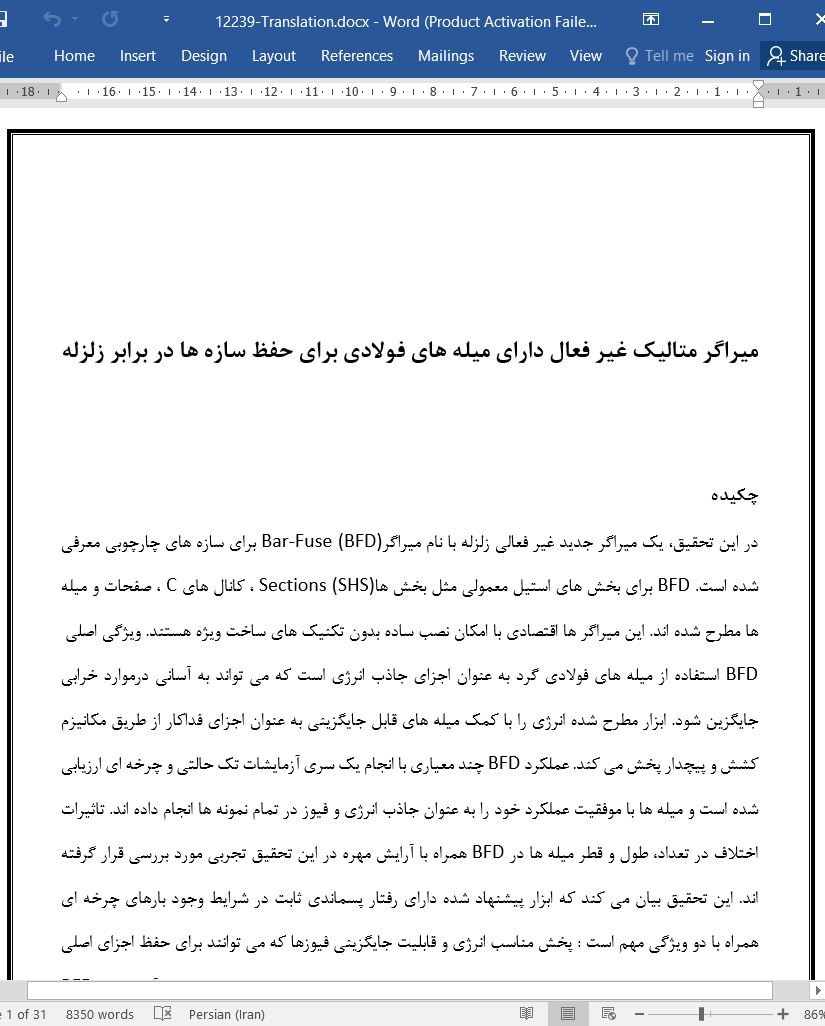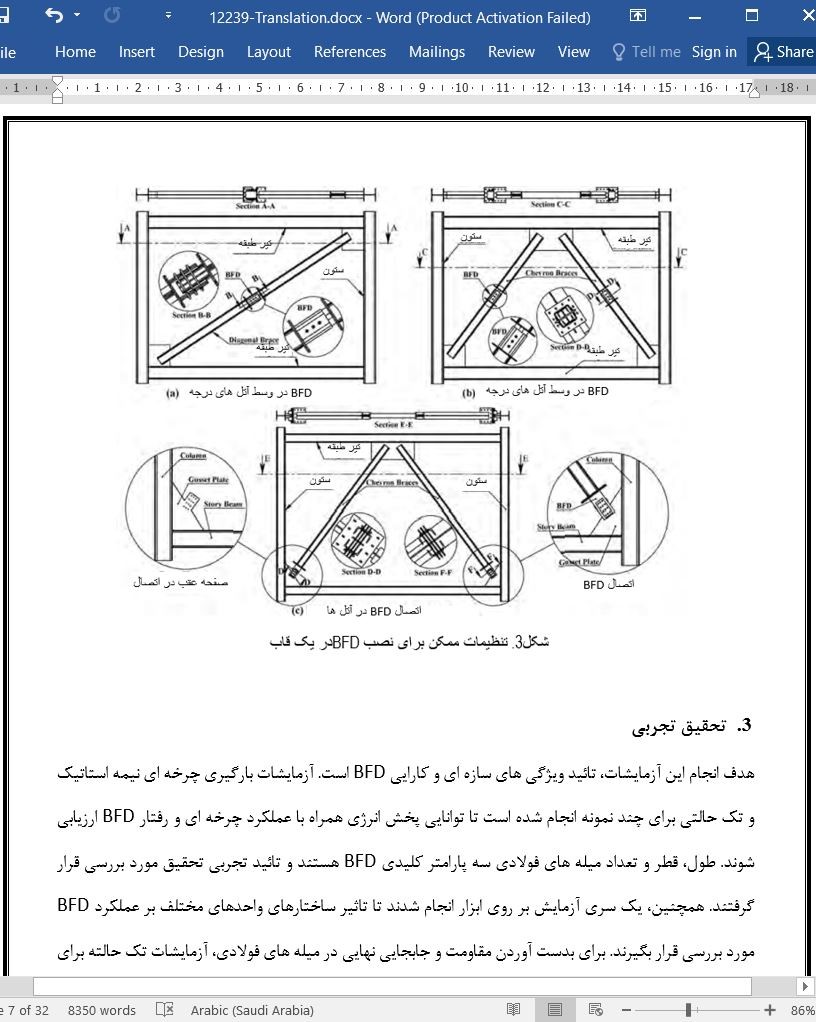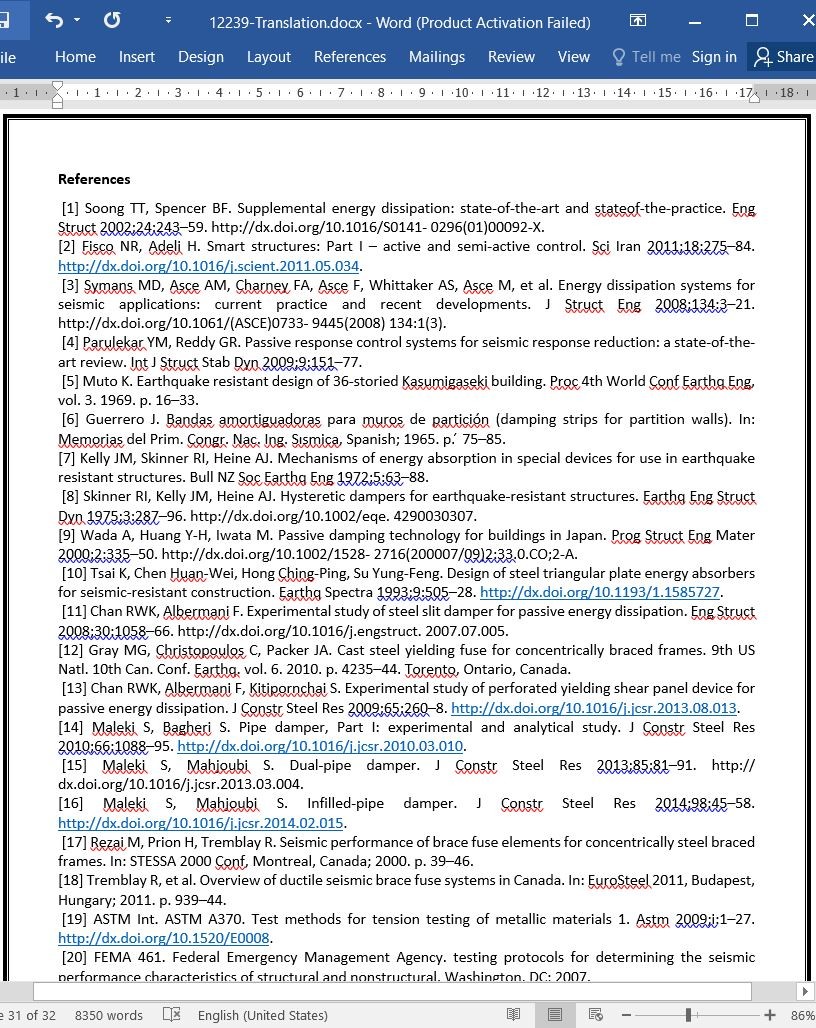
میراگر متالیک غیر فعال دارای میله های فولادی برای حفظ سازه ها در برابر زلزله
چکیده
در این تحقیق، یک میراگر جدید غیر فعالی زلزله با نام میراگر(BFD) Bar-Fuse برای سازه های چارچوبی معرفی شده است. BFD برای بخش های استیل معمولی مثل بخش ها Sections (SHS)، کانال های C ، صفحات و میله ها مطرح شده اند. این میراگر ها اقتصادی با امکان نصب ساده بدون تکنیک های ساخت ویژه هستند. ویژگی اصلی BFD استفاده از میله های فولادی گرد به عنوان اجزای جاذب انرژی است که می تواند به آسانی درموارد خرابی جایگزین شود. ابزار مطرح شده انرژی را با کمک میله های قابل جایگزینی به عنوان اجزای فداکار از طریق مکانیزم کشش و پیچدار پخش می کند. عملکرد BFD چند معیاری با انجام یک سری آزمایشات تک حالتی و چرخه ای ارزیابی شده است و میله ها با موفقیت عملکرد خود را به عنوان جاذب انرژی و فیوز در تمام نمونه ها انجام داده اند. تاثیرات اختلاف در تعداد، طول و قطر میله ها در BFD همراه با آرایش مهره در این تحقیق تجربی مورد بررسی قرار گرفته اند. این تحقیق بیان می کند که ابزار پیشنهاد شده دارای رفتار پسماندی ثابت در شرایط وجود بارهای چرخه ای همراه با دو ویژگی مهم است : پخش مناسب انرژی و قابلیت جایگزینی فیوزها که می توانند برای حفظ اجزای اصلی سازه در برابر تغییر شکل های انعطاف پذیر و خرابی در رویدادهای متعدد مفید باشند. نتایج بدست آمده برای BFD جهت استفاده به عنوان میراگر لرزه ای غیر فعال در سازه های مهندسی برای ارتقای رفتار لرزه ای سازه و همچنین پخش انرژی زلزله امیدوار کننده هستند.
1. مقدمه
در مجموع، کنترل سازه می تواند با عنوان فعال، نیمه فعال و غیر فعال نامگذاری شود (1). در سیستم های کنترل فعال و نیمه فعال، واکنش های سازه ای بر اساس ویژگی های نیروهای اعمال شده توسط سازه در زلزله یا باد متغیر می باشند. به عبارت دیگر، واکنش سازه ای نیروهای اعمال شده توسط سیستم کنترل اصلاح می شود تا بارهای ورودی حفظ شوند. این سیستم های کنترل می توانند شامل منبع انرژی، سنسورها و جک های هیدرولیک باشند (2). به عبارت دیگر، کنترل غیر فعال سازه ای مستقل از نیروهای اعمال شده توسط زلزله و یا باد هستند و فقط بستگی به نوع تجهیزات و موادی دارند که در میراگر استفاده می شوند. هدف اصلی سیستم های کنترل غیر فعال، کاهش استفاده از اجزای سازه ای اصلی در پخش انرژی ورودی حاصل از جابجایی های ارتجاعی می باشد. جدا سازهای پایه، میراگرهای متالیک قابل انعطاف، میراگرهای اصطکاک، میراگرهای چسبناک و چسبناک - انعطاف پذیر و میراگرهای مایع همگی تحت عنوان سیستم های کنترل غیر فعال دسته بندی می شوند (4و3).
7. خلاصه و نتیجه گیری ها
در این تحقیق، یک میراگر غیر فعال جدید با نام میراگر Bar-Fuse(BFD) ارائه شده است و از نظر تجربی و عددی مورد ارزیابی قرار گرفته است. عملکرد BFD با بیش از 30 آزمایش تک حالته و چرخه ای ارزیابی شده است و میله های استفاده شده با موفقیت بکار گرفته شدند و فعالیت آنها به عنوان جاذب انرژی و فیوز در تمام نمونه ها مورد بررسی قرار گرفت. ابزار معرفی شده دارای هدایت، جذب انرژی و رفتار پیچش ثابت و مناسب در شرایط بارگیری چرخه ای بدون کاهش مقاومت و استقامت می باشد. عملکرد BFD تا حد زیادی بستگی به آرایش مهره میله ها دارد. ساده ترین طراحی که دارای دو مهره است و در دو انتهای آن میله برجسته قرار دارد، دارای رقتار پایدار است و همچنین امکان جا گذاری و تعویض ساده در هنگام خرابی وجود دارد. توانایی جایگزینی مناسب می تواند یکی از ویژگیهای کلیدی ابزار معرفی شده در مقایسه با سایر میراگرهای متالیک موجود در نظر گرفته شود.
Abstract
In this paper, a new passive earthquake damper termed as Bar-Fuse Damper (BFD) is presented for frame structures. The BFD is developed from common steel sections such as hot-rolled Square Hollow Sections (SHS), C-channels, plates and bars. It is economical, easy to install and build with no special fabrication technique. The key feature of the BFD is using round steel bars as energy absorber components that can be easily replaced in case of failure. The proposed device dissipates the energy with the replaceable bars as sacrificial elements through the flexural and tensile mechanism. The performance of several full-scale BFDs was evaluated with a series of monotonic and cyclic experiments, and the bars successfully performed their function as energy absorbers and fuses in all specimens. The effects of variations in the number, length and diameter of bars in the BFD along with the nuts arrangement were investigated in this experimental study. This study indicates that the recommended device has stable hysteretic behaviour under cyclic loads with two significant features: appropriate energy dissipation and replaceability of the fuses, which can be useful to protect the main elements of structures from plastic deformation and failure for several events. The results obtained for the BFD are promising for its use as a passive seismic damper in engineering structures in order to improve the seismic behaviour of structures as well as dissipating the earthquake energy.
1. Introduction
Generally speaking, structural control can be categorized as active, semi-active and passive control [1]. In active and semi-active control systems, the structural response varies based on the characteristics of the forces applied to the structure by an earthquake or wind. In other words, the structural response to the applied forces is adjusted by a control system to sustain the input loads. These control systems may consist of a power supply, sensors and hydraulic jacks [2]. On the other hand, the passive structural control is independent of the forces applied by an earthquake or wind and only depends on the type of equipment and material that were used in the damper. The main goal of the passive control systems is to reduce the contribution of the principal structural elements in dissipating the input energy by plastic deformation. Base isolators, metallic yielding dampers, friction dampers, viscous and viscoelastic dampers, tuned mass and liquid dampers are all classified as passive control systems [3,4].
7. Summery and conclusions
In this paper a new passive earthquake damper, the Bar-Fuse Damper (BFD), was presented and evaluated both experimentally and numerically. The performance of the BFD was assessed with more than 30 monotonic and cyclic experiments, and the applied bars successfully performed their function as energy absorbers and fuses in all the specimens. The proposed device showed appropriate ductility, energy absorption and stable hysteretic behaviour under cyclic loads without any sudden strength and stiffness degradation. The performance of the BFD depends highly on the nut arrangements of the bars. The simplest design, two nuts on the both ends of the threaded bar, gave a reliable behaviour to the proposed device, as well as the possibility of convenient placing and replacing the bars when they were failed. This proper replacement capability can be considered as a key feature of the proposed device over to other available metallic dampers.
چکیده
1. مقدمه
2. میراگر میله – فیوز
3. تحقیق تجربی
3.1 نمونه ها
3.2 موقعیت آزمایش و پروتکل بارگیری
3.3 انتخاب ساختارهای مناسب مهره
3.4 نتایج تجربی و بحث
3.4.1 آزمایشات تک حالتی
3.4.2. آزمایشات چرخه ای
3.4.3.مقاومت معادل و نسبت تعدیلی
3.4.4 .پخش انرژی
3.4.5 .نمودار طراحی برای BFD
3.4.6 .مدل دو خطی برای BFD
4. مدل المان محدود
5. .محدودیت های استفاده از BFD
6. BFD و سایر میراگرهای متالیک
7. خلاصه و نتیجه گیری ها
منابع
ABSTRACT
1. Introduction
2. Bar-Fuse Damper
3. Experimental study
3.1. Specimens
3.2. Tests setup and loading protocol
3.3. Selection of proper nuts configuration
3.4. Experimental results and discussions
3.4.1. Monotonic tests
3.4.2. Cyclic tests
3.4.3. Equivalent stiffness and damping ratios
3.4.4. Energy dissipation
3.4.5. Design chart for the BFD
3.4.6. Bilinear model for the BFD
4. Finite element model
5. Limitations on application of the BFD
6. BFD and other metallic dampers
7. Summery and conclusions
References
- اصل مقاله انگلیسی با فرمت ورد (word) با قابلیت ویرایش
- ترجمه فارسی مقاله با فرمت ورد (word) با قابلیت ویرایش، بدون آرم سایت ای ترجمه
- ترجمه فارسی مقاله با فرمت pdf، بدون آرم سایت ای ترجمه



